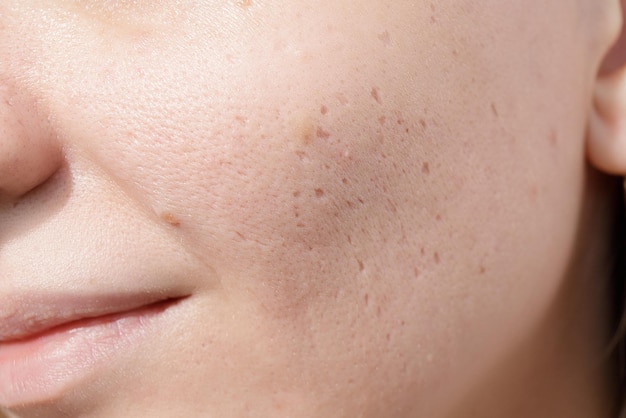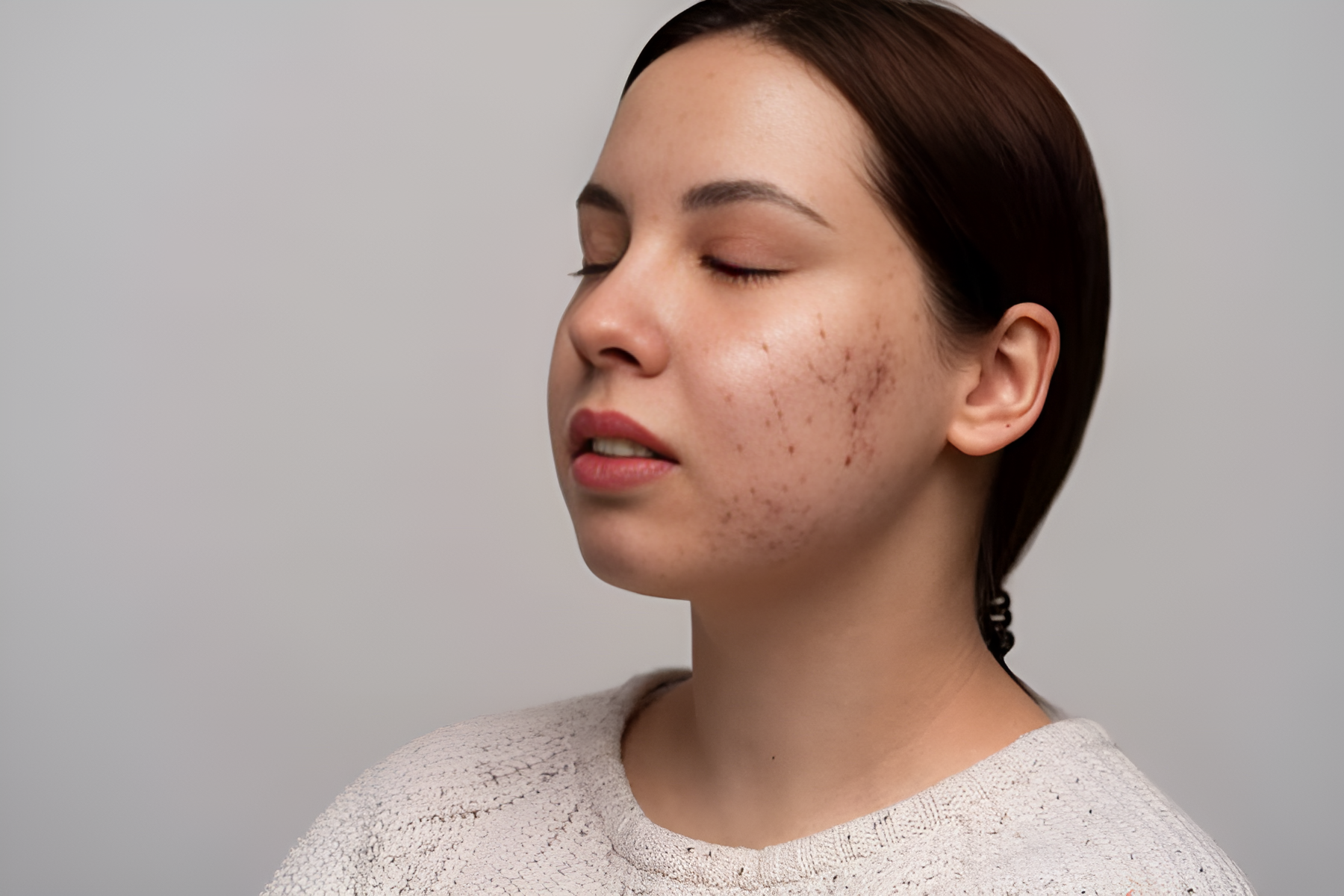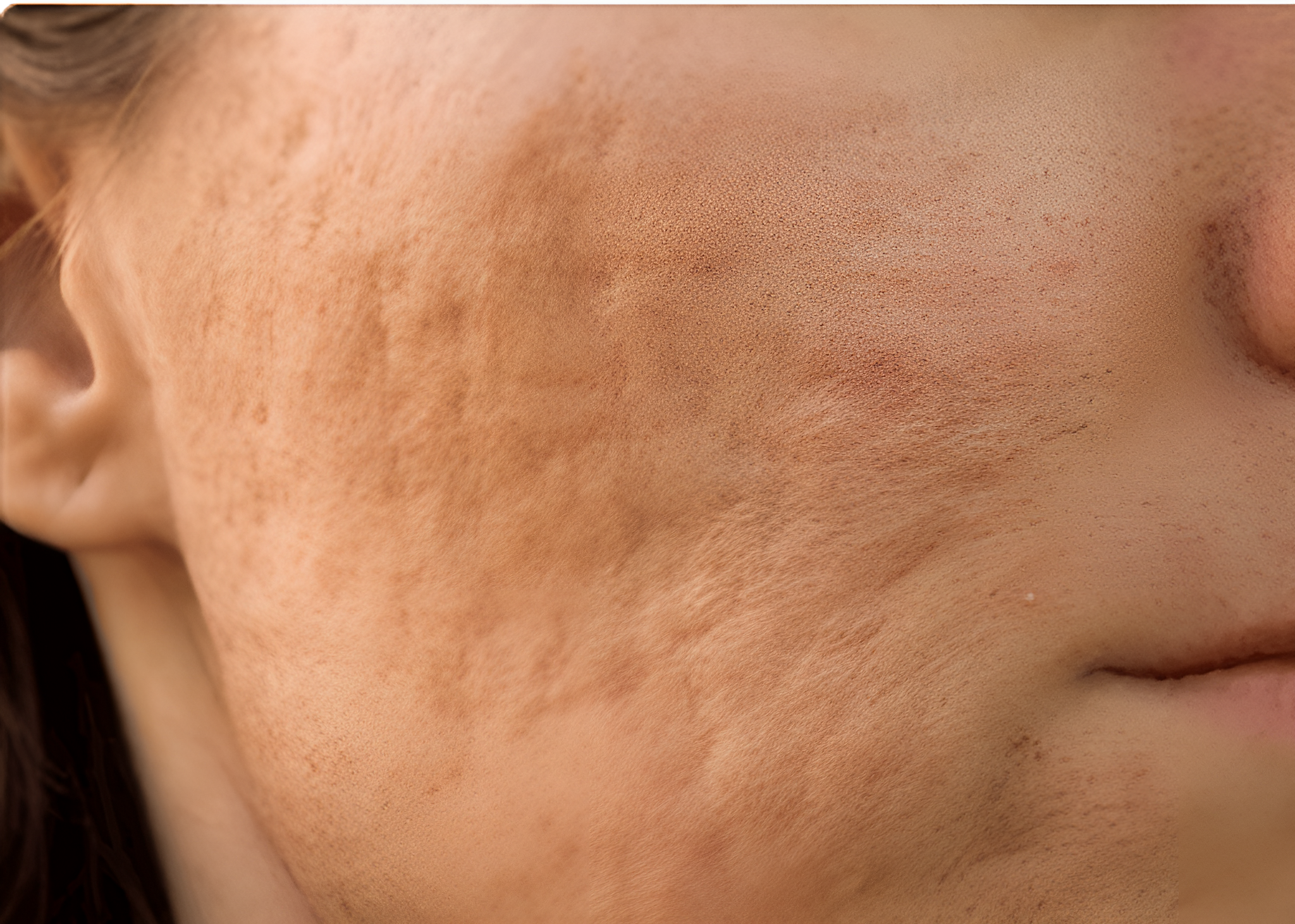Ice pick scars result from severe acne damaging the underlying skin tissue. Although they are difficult to treat, various methods can help reduce their appearance.
This article aims to provide essential information on the causes, characteristics and treatment options for this particular acne scar. Whether you’re looking to prevent these scars from forming or seeking ways to make them less noticeable, you’ll find comprehensive insights within these pages. With the right information and approach, you can take steps towards healthier skin.
What are Ice Pick Acne Scars?
Ice pick scars are characterised by a narrow, deep and pitted appearance resembling puncture marks. These are among the most challenging scars to treat and are a common form of atrophic acne scar. They form when a severe acne lesion damages the skin, extending deep into the dermis. The inflammation from the acne lesions causes tissue damage, creating a narrow, deep indentation.
Causes of Ice Pick Scars
The primary cause of ice pick scars is severe inflammatory acne, particularly cystic acne. These severe acne breakouts cause inflammation that extends deep into the skin’s inner layers, damaging the tissue. This damage destroys collagen, a protein that provides the skin structure and support, resulting in deep, narrow scars. While the body attempts to repair the damaged skin by producing collagen, it sometimes fails to produce enough to fill the depression, forming ice pick scars.
Picking or squeezing acne lesions can worsen inflammation and further damage the skin, increasing the likelihood of acne scarring.
How Ice Pick Scars Differ from Other Acne Scars
Ice pick scars differ from other acne scars in appearance and treatment challenges. Boxcar scars are broad and shallow with well-defined edges, while rolling scars have a wave-like appearance with a smoother surface.
In contrast, ice pick scars are deep, narrow indentations resembling small holes or puncture wounds. The severity and texture of ice pick scars often make them difficult to treat, as they penetrate deeper into the dermis than superficial scars.
Understanding these differences is crucial for selecting appropriate ice pick scar treatment options, as each type of scar may respond differently to various interventions.
Ice Pick Scar Treatment Options
Due to their depth and unique structure, ice pick scars are challenging to treat and often require professional intervention. Various treatments offer different benefits and work uniquely to improve scar appearance.
Chemical Peel
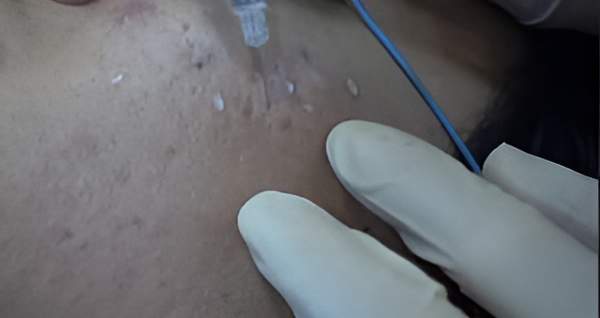
Chemical peel uses acidic solutions to remove the top layers of skin, promoting the growth of new skin. By exfoliating the outermost layer, chemical peels can help reduce the depth of ice pick scars. Trichloroacetic acid (TCA) chemical peel, particularly the CROSS technique, is used for treating ice pick acne scars.
This method involves the application of high concentrations of TCA directly in the scar. This localised treatment helps reorganise the dermal structure, encouraging new collagen formation and elevating the indented scar.
Radiofrequency Microneedling
Radiofrequency Microneedling is a minimally invasive cosmetic procedure that utilises fine needles stamped onto the skin to create small punctures. While in the skin, these fine needles produce radio frequency to aid in collagen production. These controlled micro-injuries, together with radio frequency, stimulate the body’s natural healing process, promoting collagen production and skin regeneration. As new collagen forms, it helps fill the deep indentations, gradually making their appearance less noticeable.
Laser Therapy
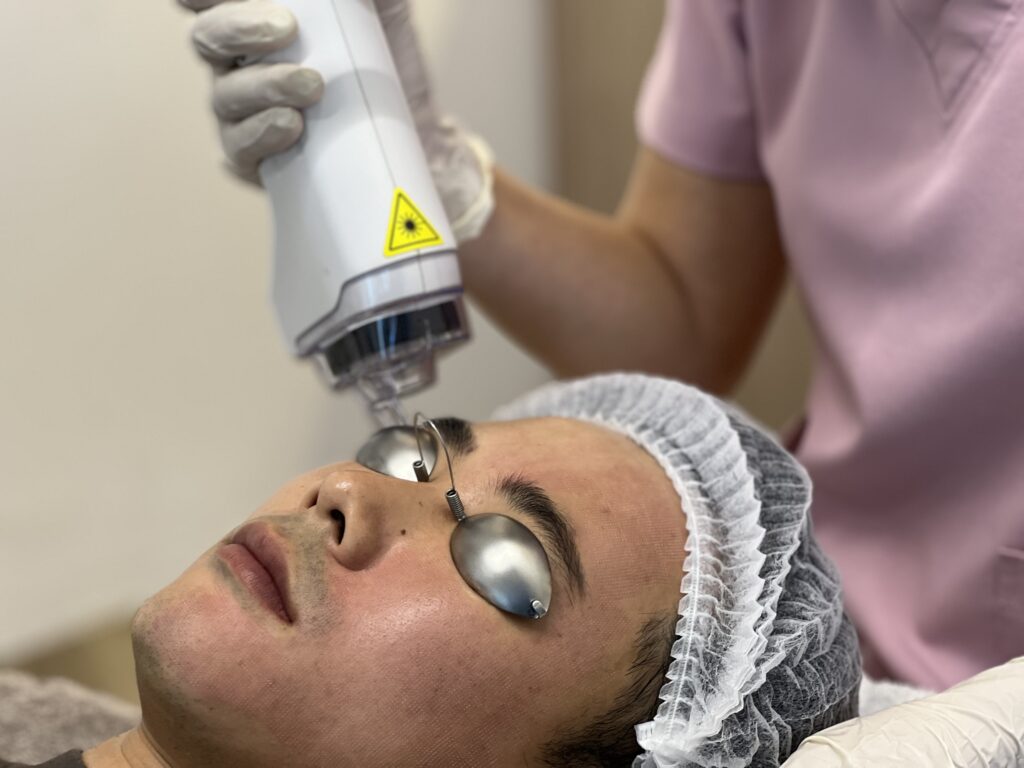
Laser treatments, such as Fractional CO2 lasers, target the skin’s deeper layers to promote collagen production and skin renewal.
Fractional CO2 lasers create micro-columns of thermal damage in the skin, triggering the body’s healing response. Fractional CO2 lasers remove the outer layer of damaged skin, allowing new, healthier skin to replace it. Laser therapy can significantly reduce the depth and visibility of ice pick scars by stimulating collagen and elastin production.
Fillers
Dermal fillers containing hyaluronic acid can be used to elevate depressed scars. Injectable hyaluronic acid is the most common type used for this procedure. Fillers add volume to the scarred area, reducing the appearance of indentations.
Punch Technique
- Punch grafting. This technique involves the removal of the scar and replacing it with a skin graft from another area of the body, such as behind the ear. Punch grafting may be employed for sharply defined or deep ice pick scars.
- Punch excision. Punch excision uses a circular punch tool to remove the scar tissue, allowing the skin to heal with a linear scar that is generally less noticeable. This technique transforms narrow, deep scars into flat, linear scars that can be more easily treated with subsequent procedures like laser resurfacing.
- Punch elevation. The scar is cut out using a punch tool smaller than the original scar. This creates a smaller wound, and the base of the scar is eventually elevated, creating a smoother transition with the surrounding skin. This technique is particularly useful for shallow ice pick scars.
Why Should You Treat Ice Pick Acne Scars
Improve Skin Appearance
One of the primary reasons to treat ice pick scars is to improve overall skin appearance. Ice pick scars can create an uneven skin texture. Addressing these scars can help individuals achieve a more uniform complexion. Treatments such as microneedling, laser resurfacing and chemical peels target the underlying damage, aiming to reduce scar visibility and improve skin texture.
Achieve Even Skin Tone
Certain treatments can help even out skin tone, making scars less noticeable. Chemical peels and laser therapy, in particular, can address hyperpigmentation and discolouration associated with acne scars. By promoting the growth of new skin, these treatments can improve overall skin tone.
Preventing Further Damage
Untreated ice pick scars can become more pronounced over time, especially if underlying acne persists. Proactively treating these scars may improve your skin’s appearance and help reduce the risk of further skin damage and scarring.
Supports Long-Term Skin Health
Treatments like Radiofrequency microneedling and Fractional CO2 lasers, can support long-term skin health by stimulating collagen production. Increased collagen helps maintain the skin’s structure and elasticity, potentially reducing the likelihood of future scarring.
How To Prevent Ice Pick Scars
1. Treat acne promptly and consistently.
Addressing acne breakouts promptly reduces the chance of deep inflammation and scarring. Early treatment can prevent acne from progressing to a severe stage, leading to ice pick scars.
2. Resist the urge to pick, pop, or squeeze pimples.

Picking or squeezing acne can worsen inflammation, leading to deeper skin damage and an increased risk of scarring. Instead, allow blemishes to heal naturally and consider using spot treatments to reduce their size.
3. Maintain a gentle skincare routine.
Establish a consistent skincare routine incorporating gentle cleansing, exfoliation and hydration to minimise the risk of acne breakouts. Using non-comedogenic products can further reduce the chance of clogged pores.
4. Avoid prolonged sun exposure.
Sun exposure can delay the healing process of acne and increase the risk of scarring. Applying broad-spectrum sunscreen can protect your skin from the sun’s harmful UV rays. This not only helps in preventing new scars but also preserves the results of any treatments received.
5. Consult with a professional.
Regular check-ins with an aesthetic doctor can help monitor your skin’s health and detect potential issues early. They can recommend personalised skincare regimens and treatment options that align with your skin concerns, significantly lowering the risk of developing ice pick scars.
Can ice-pick acne scars heal on their own?
Ice pick scars rarely heal on their own. The deep nature of these scars often requires professional treatments to see noticeable changes.
Are ice-pick acne scars permanent?
Ice pick scars are generally permanent due to their deep and narrow nature, which makes them resistant to natural healing processes. However, various acne scar treatments can reduce their appearance, making them less noticeable.
How long does it take to see results from ice pick acne scar treatments?
Results vary depending on the treatment type, individual skin types and the severity of the scars. It may take several weeks to months to notice changes, and some treatments require multiple sessions.
Can home remedies be effective for ice-pick acne scars?
Home remedies might not provide the same level of effectiveness as professional dermatological treatments, but they may offer some benefits in improving skin texture and promoting healing. Selecting appropriate remedies that align with your skin type and conditions is also important to help reduce the risk of skin irritations.
What are the potential side effects of ice pick acne scar treatments?
Potential side effects from treatments for ice pick scars may vary depending on the procedure used. Common side effects include discomfort, redness, post-inflammatory hyperpigmentation, swelling and temporary skin sensitivity in the treated area.
Is it possible to get rid of ice pick acne scars after treatment?
While eliminating ice pick scars may not always be achievable, scar reduction can be achieved following appropriate treatment. Patient adherence to treatment regimens and aftercare advice is crucial for promoting better outcomes, as this consistency supports the healing process.
How much do treatments for ice pick acne scars cost in Singapore?
The cost can vary depending on the type of treatment, the extent of the scarring and the frequency of the chosen treatment. TCA CROSS treatment typically starts from $250*. Our doctor will work with you to determine the best treatment options and create a personalised care plan.
Can diet and lifestyle changes help prevent ice pick acne scars?
Diet and lifestyle changes can help improve skin health and reduce the risk of severe acne and scarring. Maintaining a balanced diet and proper hydration supports skin health. Reducing stress, getting adequate sleep and following a consistent skincare routine can also help prevent acne breakouts.
How do I choose the right treatment for my ice pick acne scar?
Choosing the right treatment for ice pick acne scars involves consulting with a qualified professional who can evaluate your skin type, scar severity and overall skin health. They can recommend tailored treatments based on your needs, helping you make an informed choice.
Can ice-pick acne scars recur after treatment?
While treated scars typically do not recur, new acne breakouts can cause new scars if not properly managed. Maintaining good skin care practices and addressing acne can help prevent future acne scarring.
Conclusion
Ice pick scars can be stubborn, but with the right treatment, improvements are possible. Understanding the different acne treatment options and consulting with an aesthetic doctor can help improve your skin’s appearance. Remember, prevention is important, so practising good skincare habits and seeking early treatment for acne can help reduce the likelihood of developing ice pick scars.


